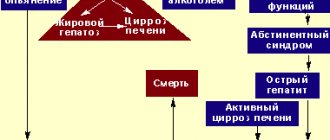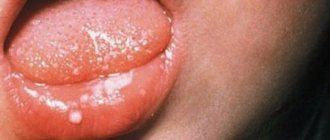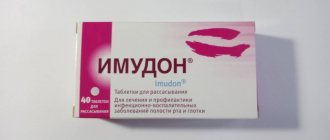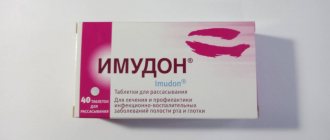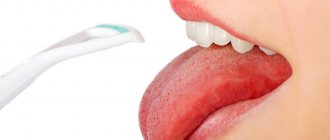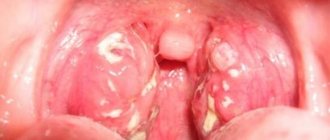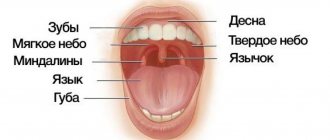Allergic laryngeal edema is a pathological condition characterized by inflammation of the mucous tissues of the larynx and narrowing of its lumen (stenosis). It occurs due to the body’s contact with factors hostile to it – allergens.
Author:
- Sadykhov Rahim Agalarovich
ENT pathology expert
2.53 (Votes: 45)
Allergic laryngeal edema is a pathological condition characterized by inflammation of the mucous tissues of the larynx and narrowing of its lumen (stenosis). It occurs due to the body’s contact with factors hostile to it – allergens, which cause a negative immune reaction. The main danger of edema is depression of respiratory function. As the lumen of the larynx narrows, breathing becomes difficult, which provokes oxygen deficiency, which is life-threatening.
Quincke's edema in children
- Symptoms of the disease
- How does Quincke's edema begin in a child?
- Causes
- First aid
- Treatment of Quincke's edema in children
Attacks most often occur in children with urticaria. Pediatricians associate swelling with hay fever, bronchial asthma, and atopic dermatitis.
Important! This is a dangerous condition, which in a quarter of cases provokes swelling of the larynx.
Quincke's edema occurs in newborns and older children. Its nature is most often allergic, but this phenomenon can be hereditary and also have no clear origin. Source: I.I. Balabolkin. Urticaria and angioedema in children // Pediatrics, 2009, v. 87, no. 2
The prognosis is usually favorable; it becomes poor with frequent relapses and associated swelling of the internal organs and larynx. The consequences may be anaphylactic shock, bronchospasm.
For prevention, in some cases vaccination is carried out. Its necessity is determined individually. Clinical recommendations for parents: provide the child with a low-allergen diet, take antihistamines at intervals recommended by the doctor, minimal or no contact with the allergen.
Causes of throat allergies
There are many reasons for throat allergies . The main ones are listed below:
- Hereditary predisposition to allergies;
- Frequent colds in humans from early childhood, which is a consequence of decreased immunity;
- Poor nutrition from childhood;
- Late or incorrect vaccination;
- Living in an environment contaminated with allergens.
Allergies in the throat can occur to tobacco smoke, poplar fluff, plant pollen, and pet hair.
Sometimes an allergic reaction in the throat is associated with inhaling cold air.
Symptoms of the disease
The reaction develops rapidly; signs of angioedema in children are swollen lips, neck, and face. The upper torso, hands, feet, and genital area are often affected. Quincke's edema is visible in the eyes of a child - the eyelids swell on one or both sides.
- When the tonsils are affected, the picture is similar to a sore throat.
- Edema of the larynx is indicated by a hoarse voice, difficulty breathing, a gusty cough, blue discoloration and then gradual paleness of the skin.
- Swelling that appears in one area may occur in another. This mainly applies to large-scale swelling.
- When the mouth and tongue swell, speech becomes difficult.
- If the process is localized in the gastrointestinal tract, the child may complain of tingling of the tongue, followed by diarrhea and vomiting, and sharp pain in the intestinal area.
- Rarely, swelling of the meninges occurs. With it, the child cannot fully tilt his head forward, complains of a headache, and behaves inhibited. Convulsions and vomiting may occur.
- If only the skin is affected, joint pain, fever may appear, and the child may lose consciousness.
The pathological condition can last from an hour to several days.
How does angioedema begin in a child?
Immediately after contact with the allergen, the listed symptoms increase sharply. This happens in a matter of minutes. Source: G. I. Smirnova. Urticaria and Quincke's edema // Allergic diseases in children. Ed. M.Ya. Studenikina, I.I. Balabolkina. M.: Medicine, 1998: 279-287 If you press on the swollen area, the child will not experience pain, but you will feel a dense swelling, on which, after pressing, there will be no characteristic depression.
About throat allergies
An allergy in the throat in its symptoms is sometimes similar to a cold or acute respiratory viral infection. That is why it is often confused with these ailments. Such an allergy in the throat can occur to plant pollen, house dust, pet hair, and so on. Allergies in the throat can manifest themselves at any time of the year and last indefinitely (a week, a month).
According to statistics, about 15% of the entire earth's population suffers from allergies. Allergies manifest themselves differently in each person, individually. That is, everything depends on the specifics of the human immune system. In addition, the allergic reaction depends on the allergen itself.
Video - diagnosis and treatment of allergies, 12:17 min
But almost always, the upper respiratory tract is the first to be affected - the nasal passages and throat, because they are the “protective barrier” from foreign bodies that enter the body through airborne droplets. Therefore, throat allergies are a very common disease .
Allergies in the throat are manifested by various diseases. Among them there are pharyngitis, laryngitis, tracheitis and others. Here are some of them:
Throat allergies are a common condition.
- Allergic pharyngopathy: swelling of the throat, including the palate and uvula, is observed; there is a change in the timbre of the voice, a feeling of “coma” appears in the throat, which is impossible to cough up.
- Allergic laryngitis is manifested by inflammation of the larynx. Symptoms include: sore throat, hoarseness, difficulty swallowing and breathing (which can lead to choking). Swelling of the larynx is also observed.
- Allergic tracheitis (inflammation of the trachea). The symptoms are similar to allergic laryngitis, and also include the following: cough, throat discomfort, scratching, hoarseness.
Causes
A complex of immunological reactions is most often caused by:
- Food;
- medicines;
- volatile allergens (pollen, chemicals, etc.);
- insect bites.
The disease may be non-allergic in nature. In this case, in addition to allergens, it is caused by: stress, infectious diseases, external factors (for example, hypothermia), intoxication of the body. Source: A. V. Lyapunov. Urticaria and Quincke's edema in children // Children's allergology. Ed. A.A. Baranova, I.I. Balabolkina. M.: GeotarMedia, 2006; 486-497.
Medicine also knows quite a lot of cases where the reason for such a reaction of the body has not been established.
Diagnosis and treatment
At the appointment, the doctor collects anamnesis, examines and palpates the larynx. If necessary, bronchoscopy and laryngoscopy procedures, X-rays, and computed tomography are performed.
Allergic swelling of the larynx is treated with medication or surgery. Medicines include antihistamines, which suppress the action of histamine, and glucocorticosteroids, which block the inflammatory response and swelling and suppress the immunological response to the allergen. Surgical intervention is a tracheostomy, an emergency measure when a person is at immediate risk of suffocation - inserting a breathing tube into the trachea through a small incision in the throat.
First aid
call an ambulance immediately . Doctors may decide on emergency hospitalization if the patient has difficulty breathing, a swollen tongue, or symptoms indicating intestinal damage.
What to do before the doctors arrive?
First aid, which should be provided at the first symptoms of angioedema in children, involves clearing the airways, checking breathing intensity, heart rate, and blood pressure. Sometimes it is necessary to perform cardiopulmonary resuscitation, so after the first case, parents are recommended to take first aid courses. At the final stage, medications should be administered to the child.
First aid equipment includes:
- glucocorticosteroids (“Prednisolone”, “Dexamethasone”);
- antihistamines;
- adrenalin.
Sequence of administration: adrenaline, then glucocorticosteroid, then antihistamine. If the reaction is moderate, then adrenaline is excluded.
| Adrenalin | It is injected intramuscularly into the thigh (middle third outside) at the rate of 0.01 mg for each kg of the child’s weight. If there is no effect, then the injections are repeated every 15 minutes. |
| Glucocorticosteroids | Injected intramuscularly into the buttock or intravenously. You can pour the medicine from the ampoule under the tongue - this way the effect will come faster. The dosage of Prednisolone is from 60 to 150 mg, Dexamethasone is from 8 to 32 mg. |
| Antihistamine | Intramuscular injection is preferable. It is possible to take a pill, but the effect will come later. The dosage depends on the medicine. For example, “Loratadine” – 10 mg, “Cetrizine” – 20 mg. |
Important! In case of swelling of the larynx, a tracheostomy is performed urgently.
Diarrhea due to food allergies
Researcher Kozyarin points out the high probability of diarrhea with food allergies: “If a person is not treated, then he may experience inflammation of the stomach and small intestine with abdominal pain and constant stool upset” (Kozyarin N.P., 2009, p. 66).
Allergies disrupt the frequency of bowel movements, with diarrhea observed for several days, which is often followed by constipation. This is not harmless, especially for people who already have intestinal problems.
Damage to the walls of the intestines and stomach leads to disruption of the processes of digestion and absorption of nutrients. If measures are not taken in a timely manner, thickening of the walls, a decrease in the intestinal lumen, and serious consequences in the form of persistent stool disorders and abdominal pain are possible.
An allergic reaction disrupts the balance of intestinal microflora . The mechanisms of influence of allergic processes on digestion are so diverse that independent gastroenterological diseases often develop, such as gastritis, peptic ulcers, and enzymatic deficiency in children. At the same time, treatment of these pathologies by a specialized specialist without adjusting the diet and taking measures to eliminate allergies is not always successful.
Diarrhea due to allergies can independently lead to complications - proctological pathologies, water-salt imbalance, and dehydration. Therefore, it is important to resort to symptomatic therapy before basic measures take effect.
Treatment of angioedema in children
- stopping contact with the allergen;
- removal of the allergen from the body (sorbents, drinking plenty of fluids);
- the use of antihistamines, glucocorticosteroids, diuretics and other drugs, depending on individual indications.
The treatment plan may vary and include other interventions and complex drug therapy. It depends on the type of disease, the number of relapses and other factors. It is necessary to obtain specialist advice.
Sources:
- I.I. Balabolkin. Urticaria and angioedema in children // Pediatrics, 2009, v. 87, no. 2.
- G. I. Smirnova. Urticaria and Quincke's edema // Allergic diseases in children. Ed. M.Ya. Studenikina, I.I. Balabolkina. M.: Medicine, 1998: 279-287.
- A. V. Lyapunov. Urticaria and Quincke's edema in children // Children's allergology. Ed. A.A. Baranova, I.I. Balabolkina. M.: GeotarMedia, 2006; 486-497.
Grek Elena Anatolyevna Clinic
Author of the article
Grek Elena Anatolyevna
Doctor of the highest qualification category
Specialty: allergist
Experience: 24 years
The information in this article is provided for reference purposes and does not replace advice from a qualified professional. Don't self-medicate! At the first signs of illness, you should consult a doctor.
Foods and additives that cause allergies
Doctors Sidorovich and Luss write that “almost any food product can act as an allergen and cause the development of food allergies. However, the most pronounced sensitizing properties are in products of protein origin containing animal and plant proteins” (Sidorovich O.I., Luss L.V., 2016, p. 141). The table shows the most common allergens in food:
| Plant food | Raspberries, strawberries, wild strawberries, black currants, blackberries, pineapple, melon, persimmon, pomegranate, citrus fruits, chocolate, tomatoes, nuts, honey, mushrooms, wheat, soybeans, carrots |
| Animal food | Milk, eggs, fish, crustaceans and seafood, cold processed chicken |
| Supplements | Pesticide residues and agricultural fertilizers in plant foods. Dyes (especially tartrazine, erythrosine, sodium nitrite), flavorings (glutamates), preservatives (benzoates, benzoic acid, sulfites), enzymes, thickeners, emulsifiers, bacteriostatics, flavor enhancers (monosodium glutamate), etc. |
Note that allergen additives provoke so-called false reactions, or pseudo-allergies. In this case, food antigens can act without the participation of allergic antibodies on target cells or activate certain biological systems; they are not based on immune reactions.
An increase in the level of histamine in the blood may not be associated with a true allergy, but with the consumption of foods containing it in large quantities: fermented cheeses, sauerkraut, dried ham, canned food, spinach.
Prices
| Name of service (price list incomplete) | Price |
| Appointment (examination, consultation) with an allergist-immunologist, primary, therapeutic and diagnostic, outpatient | 1950 rub. |
| Prescription of treatment regimen (for up to 1 month) | 1800 rub. |
| Consultation (interpretation) with analyzes from third parties | 2250 rub. |
| Consultation with a candidate of medical sciences | 2500 rub. |
| Allergen-specific immunotherapy (ASIT) - maintenance course (excluding the cost of the drug) | 8100 rub. |
Types of edema
Depends on origin:
- Lymphatic - those types of edema that are caused by causes and changes associated with the lymphatic system are considered as such. Among them are primary (there are congenital malformations of the lymphatic system, usually affecting the limbs), or secondary (there are acquired damage). The latter may be the result of operations to remove tumors in the lymphatic system, or in cases of burns, strokes or infections that cause vessel destruction.
- Dynamic - the lymphatic system does not show any changes, but excess fluid is felt. These include swelling of the veins caused by blood clots or problems with the blood vessels caused by strokes, inflammation, and medications. In women, the cause is varicose veins and exposure to hormones during pregnancy and the postpartum period.
The main factors are changes in the biochemical composition of tissue fluid and blood plasma. Disturbances also occur against the background of hormonal changes and increased capillary permeability.
Treatment of rhinitis in acute respiratory viral infections with first generation antihistamines
The most common causes of respiratory system diseases are acute respiratory viral infections (ARVI). According to the World Health Organization, an adult experiences ARVI twice a year. In children, the incidence of ARVI is on average 3 times higher than in adults. Temporary disability of the adult population due to ARVI in Russia annually accounts for 25-30% of the total temporary disability and causes great economic damage. Patients with ARVI are the main contingent of patients in the clinic, therefore one of the main tasks of the doctor is to reduce the incidence of ARVI and reduce the period of temporary disability, and this can only be achieved with timely detection and, most importantly, with optimal treatment of this category of patients.
The ARVI group consists of etiologically independent diseases, the most important of which are influenza, parainfluenza, RS virus, rhinovirus and adenovirus infection; They are united by two main features: a single mechanism of pathogen transmission and similar clinical manifestations of the infectious process.
Indeed, different groups of respiratory viruses can cause almost identical lesions, but an etiological diagnosis can only be made based on the results of serological diagnosis, performed only in order to control the epidemiological situation, which, unfortunately, is not always achievable in an outpatient setting.
One of the main and most important manifestations of most acute respiratory viral infections is rhinitis. The International Rhinitis Group defines it as “inflammation of the nasal mucosa, characterized by one or more symptoms: nasal congestion, rhinorrhea, sneezing, nasal itching.” Typically, the disease debuts with the appearance of malaise, a feeling of dryness in the nose, and sneezing. Then swelling of the nasal mucosa quickly increases, and rhinorrhea appears.
Therapeutic tactics depend on the severity of the pathological process. If the course of the disease is fairly mild and there is no threat of complications, it is advisable to use non-drug treatment methods (steam inhalations, rinses, hot foot baths, dry heat on the lower back and feet, diaphoretic procedures), and vitamin therapy is indicated. With pronounced symptoms of acute rhinitis, the patient’s general well-being suffers, his performance decreases, and his quality of life deteriorates. Due to swelling of the mucous membrane of the paranasal sinuses and Eustachian tubes, a headache appears in the forehead and a feeling of congestion in the ears. There may be narrowing or blockage of the nasolacrimal canal, which is manifested by profuse lacrimation, painful swelling of the lacrimal sac, and there is a threat of complications from the paranasal sinuses and middle ear. It is the likelihood of the process becoming chronic and developing complications that justifies the advisability of using medications for acute rhinitis. However, it is necessary to take into account the peculiarities of the psychology of the majority of patients who prefer to use one, maximum two “all-healing” remedies. Prescribing 3-4 medications that must be taken several times a day leads to the patient beginning to doubt the correctness of the doctor’s prescriptions, violate the medication regimen, and as a result, the effectiveness of treatment decreases. Thus, in outpatient practice, it can be considered most preferable to prescribe drugs that have a sufficient breadth of therapeutic action, relieve the main symptoms of the disease, cover pathogenetically significant paths of its development and allow minimizing the amount of medication taken.
Being a permanent component of almost all organs, tissues, fluids and secretions of the human body, histamine mediates its physiological and pathological effects through three types of membrane receptors (H1, H2, H3) located on the smooth muscle cells of internal organs and blood vessels, endothelial cells , nerve endings, peripheral blood leukocytes. Contraction of smooth muscles, increased vascular permeability, increased mucus secretion in the upper respiratory tract, increased intracellular concentration of cGMP, pulmonary vasoconstriction, increased chemotaxis of eosinophils and neutrophils, increased production of thromboxane, prostaglandins F2a, E2 and similar arachidonic acid derivatives are realized through the activation of H1-histamine receptors [ 12].
The need to eliminate the pathological effects of histamine led to the search and then the introduction into clinical practice of drugs that competitively block H1-histamine receptors. However, the term “antihistamine” does not fully reflect the essence of these drugs, since they cause a number of other pharmacological effects. This is partly due to the structural proximity of such local hormones as histamine, adrenaline, serotonin and acetylcholine: a substance that eliminates the effects of one stimulant can block the effect of another [3]. The accompanying pharmacological effects of first-generation antihistamines were considered undesirable, which led to the introduction of the following generations of antihistamines into clinical practice. However, first generation H1 blockers, which have anticholinergic properties, have found use as mediator therapy for acute respiratory viral infections.
The use of first-generation antihistamines brompheniramine, chlorpheniramine, chloropyramine for ARVI, in contrast to second-generation H1-blockers, highly effectively reduces symptoms of rhinitis such as swelling of the mucous membrane and nasal congestion, rhinorrhea, sneezing and itching in the nose [5-8]. The mechanisms of action of first generation antihistamines are associated both with their ability to block H1-histamine receptors and with competitive antagonism of muscarinic receptors, which mediate parasympathetic stimulation of glandular secretion and vasodilation. In addition, due to the ability of these drugs to penetrate the blood-brain barrier, they affect the corresponding receptor formations in the medulla oblongata and hypothalamus [9].
The overall assessment of the effectiveness of ARVI treatment, independently carried out by patients and attending physicians on a 4-point scale (0 - no effect, 1 - moderate effect, 2 - good effect, 3 - excellent effect), when using Suprastin, averages 2.6 points, which significantly exceeds the same indicator in the group of patients who did not use suprastin (1.9 points).
Thus, first generation antihistamines (for example, suprastin) are highly effective drugs and can be recommended for symptomatic and pathogenetic therapy of rhinitis in acute respiratory viral infections. Small dosages and the possibility of prescribing drugs in short courses make it possible to avoid side effects or minimize them [4].
Literature
- Clinical immunology and allergology/Under. ed. L. Yeager. M.: Medicine, 1990. T. 1. P. 155-156.
- Kotova S. L., Berezhnaya N. M. Intracellular regulation of the interaction of histamine with receptors in normal conditions and in atopy // Immunology. M.: Medicine, 1992. No. 5. P. 4-7.
- Lawrence D. R., Bennit P. N. Clinical pharmacology. M.: Medicine, 1991. T. 2. P. 486-491.
- Bender BG, McCormick DR, Mildrom H. Children's school performance is not imparied by short-term administration of diphenhydramine or loratadine//J. Pediatr. 2001. Vol. 138(5). P. 656-660.
- Gaffey MJ, Kaiser DL, Hayden FG Ineffectiveness of oral terfenadine in natural colds: evidence against histamine as a mediator of common cold symptoms//Pediatr. Infect. Dis. J. 1988. Vol. 7(3). P. 223-228.
- Gwaltney JM, Jr., Druce HM Efficacy of brompheniramine maleate for the treatment of rhinovirus colds//Clinical Infectious Diseases, 1997. Vol. 25. P. 1188-1194.
- Gwaltney JM, Jr., Park J., Paul RA, Edelman DA, O'Connor RR, Turner RB Randomized controlled trial of clemastine fumarate for treatment of experimental rhinovirus colds//Clinical Infectious Diseases. 1996. Vol. 22. P. 656-662.
- Gwaltney JM Jr., Winter B., Partie JT, Hendley JO Combined antiviral-antimediator treatment for the common cold//J. Infect. Dis., 2002. Vol. 186(2). P. 147-154.
- Muether PS, Gwaltney JM, Jr. Variant effect of first- and second-generation antihistamines as clues to their mechanism of action on the sneeze reflex in the common cold //Clinical Infectious Diseases. 2001. Vol. 33. P. 1483-1488.
A. A. Stremoukhov, Doctor of Medical Sciences E. B. Mishchenko, Candidate of Medical Sciences
MMA im. I. M. Sechenova, Moscow
In practice, to relieve the symptoms of rhinitis during ARVI, the most preferable is the use of chloropyramine (suprastin). According to our data, the administration of Suprastin twice a day at a daily dose of 50 mg (25 mg per dose) for 5 days, starting from the first day of the disease, allows already on the second day of taking the drug to reduce congestion and nasal discharge, in addition, the patient begins to sneeze less often. On the 4th–5th day of treatment with suprastin, nasal breathing is practically restored, nasal discharge, sneezing and itching in the nose stop (see figure).
| Dynamics of rhinitis symptoms during treatment with suprastin (own data) |
Our analysis of the dynamics of the disease in groups comparable in gender, age and nature of the pathological process showed that in patients receiving Suprastin, rhinitis symptoms regress 1.6 - 2.3 times faster. As the manifestations of rhinitis are relieved, the patient’s general condition improves, the intensity of the sore throat decreases, and the severity of the cough syndrome caused by the flow of discharge from the nasal cavity into the larynx and trachea decreases. In addition, the use of Suprastin makes it possible not to resort to the use of nasal vasoconstrictor drugs, which, with prolonged use, in some cases can themselves cause drug-induced rhinitis. Patients already using nasal decongestants can significantly reduce the frequency of their use.
Allergy prevention
Patients who have suffered an episode of drug allergy are contraindicated in the future to take the drug that provoked the attack. It is important to know that other drugs that have the same chemical properties can also be dangerous. This is due to the fact that the body reacts in the same way to chemically similar molecules. Drug allergies that develop due to substances of similar composition are called cross allergies.
There are lists and lists of medications that may cause cross-reactions. For example, if you are allergic to a drug from the group of beta-lactam antibiotics, you should not take other medications from this group.
It is important to ensure that the components of the allergen medication are not included in the complex medications used (many anesthetics are combination drugs).
There is also a rule that patients with allergies are not recommended to be prescribed more than three different drugs at the same time.
How to avoid the reappearance of allergic edema?
So that the surprise does not take you by surprise again, you need to consult with an allergist and try to figure out who was the source of the allergy. For this purpose, skin allergy tests, special blood tests, and provocative tests have been developed.
Knowing your allergen, you can realistically avoid contact in the future, or take preventive measures in a timely manner, starting to take antihistamines in advance if you cannot avoid unwanted contact.
Allergic edema is widespread, and its main problem is that many of us cannot figure out its allergic nature for a long time. They limit their fluid intake, refuse beer and tea, subscribe to “quick drying” channels on social networks, and buy expensive cosmetics. But everything is useless, the swelling persists, or even progresses. It is not surprising, because if the basis of edema is an allergic reaction, it is necessary first of all to act on the allergy systemically, taking antihistamines, and instead of using ordinary ointments, but hormonal ointments intended to relieve allergic edema.
If you still have questions, you can ask them to an allergist using the Doctis service.
What are the common treatments for allergic edema?
Edema, although located on the face or limbs, is a manifestation of a systemic disease - allergies. This means that you cannot do without medications that act systemically on the body (that is, tablets).
In case of massive acute edema, adrenaline, hormones, and antihistamines are administered intravenously to relieve them. Let's leave this work to emergency doctors.
Local acute as well as chronic edema require taking tableted antihistamines. Often this treatment is a course of treatment, covering the entire period of action of the allergen, for example, flowering. Or for the entire duration of the visit, a dusty room, for example, an old library or museum storeroom. I understand that among the readers there are those who do not like pills, but alas, without antihistamines it will not be possible to quickly relieve allergic edema.

